TY-8 Sŭngri
| TY-8 Sŭngri | |
|---|---|
 Test launch of a TY-8G missile | |
| Type | SRBM |
| Service history | |
| In service | 2012-present |
| Used by | Menghe |
| Production history | |
| Manufacturer | Institute 57 |
| Specifications | |
| Weight | 6,100 kg |
| Length | 8.9 m |
| Diameter | 1.0 m |
| Warhead | 600 kg HE |
| Engine | Single-stage solid-fuel rocket |
Operational range | 700 km (430 mi) |
| Speed | Mach 6 (terminal) |
Guidance system | Inertial guidance and Constellation satellite navigation (TY-8G) Inertial guidance and terminal terrain contour matching (TY-8N) |
| Accuracy | 5 meter CEP |
Launch platform | Road-mobile TEL |
The TY-8 Sŭngri ("Victory" in Menghean) is a short-range ballistic missile developed in Menghe during the late 2000s. It carries a non-nuclear warhead and is intended to deliver precision strikes against critical infrastructure or high-value rear-area units. With a variety of guidance options, it is very accurate, and can perform terminal evasive maneuvers to complicate interception by anti-ballistic missile systems.
Development
After the Decembrist Revolution, the Menghean government agreed to suspend work on any ballistic missile with a range of more than 300 kilometers, and scrap most of its existing medium-range ballistic missile stockpile. This move was intended to improve relations with neighboring Dayashina, which had been the target of missile threats in the 1980s, when Ryŏ Ho-jun was developing Menghe's illegal nuclear weapons.
Following the tense outcome of the Ummayan Civil War in 2005, Menghe's government announced that it was lifting its self-imposed moratorium on missile testing, and would develop a new short-range ballistic missile to protect the border with Maverica and Innominada. By this time, relations with Dayashina had improved to the point that the lifting of the limitation was not a serious diplomatic issue.
Institute 57, the design agency responsible for work on the DPRM's previous missiles, used the tactical-range TY-7 missile as the basis for the new design, scaling up the solid-fuel motor and the warhead. Missile tests were conducted over the Western Desert in 2008 through 2010, and after some changes to the design, the Ministry of National Defense declared the missile to be in operational service in February 2012.
Description
Like many other ballistic missiles in its mass and range class, the TY-8 has a steep conical profile over the first 1/3 of its length, and a cylindrical profile for the remainder, a shape intended to balance subsonic and supersonic performance. It has guidance fins on the tail, and graphite thrust vectoring panels behind the booster. Thrust is powered by a single-stage solid-fuel rocket motor, and range is reportedly 700 kilometers.
Two guidance modes are available for the TY-8. The TY-8G relies on a combination of inertial guidance and satellite navigation via the Constellation Satellite Navigation System, and has a circular error probable of 5-7 meters on satellite guidance and 50 meters if only inertial guidance is available. The TY-8N has a distinct "lens" atop the nose, and uses infrared-spectrum terrain contour matching to reference its view against data from satellites or reconnaissance aircraft. Both types of missiles can reportedly release decoys and conduct high-G terminal maneuvers on approach, increasing the probability that they will slip past SAM and ABM defenses.
The missile is carried and launched by an eight-wheeled TEL based on the Taekchŏn T512 truck. This launcher has a crew of three, and can make preparations to launch in 4 minutes from high-readiness and 15 minutes from a road march. The cabin is equipped with a CBRN filtration system, but neither the cabin nor the launch vehicle are armored.
A complete launch battery for the TY-8 missile consists of:
- 1 command post vehicle
- 6 TEL vehicles
- 1 maintenance and repair vehicle
- 1 CBRN protection storage vehicle
as well as training and instructional equipment, if the battery is not part of a larger unit.
TY-8H Anhae
The TY-8H Anhae is an anti-ship variant of the TY-8 missile, developed for use in the coastal defense role. It uses the same electro-optical seeker as the TY-8N, though its programing is altered, to seek out the infrared signatures of ships against an ocean background. A mid-course correction option was also added, allowing launch teams to adjust the trajectory based on updates on the enemy fleet's movement. The land-launched version of the TY-8H was declared operational in 2014.